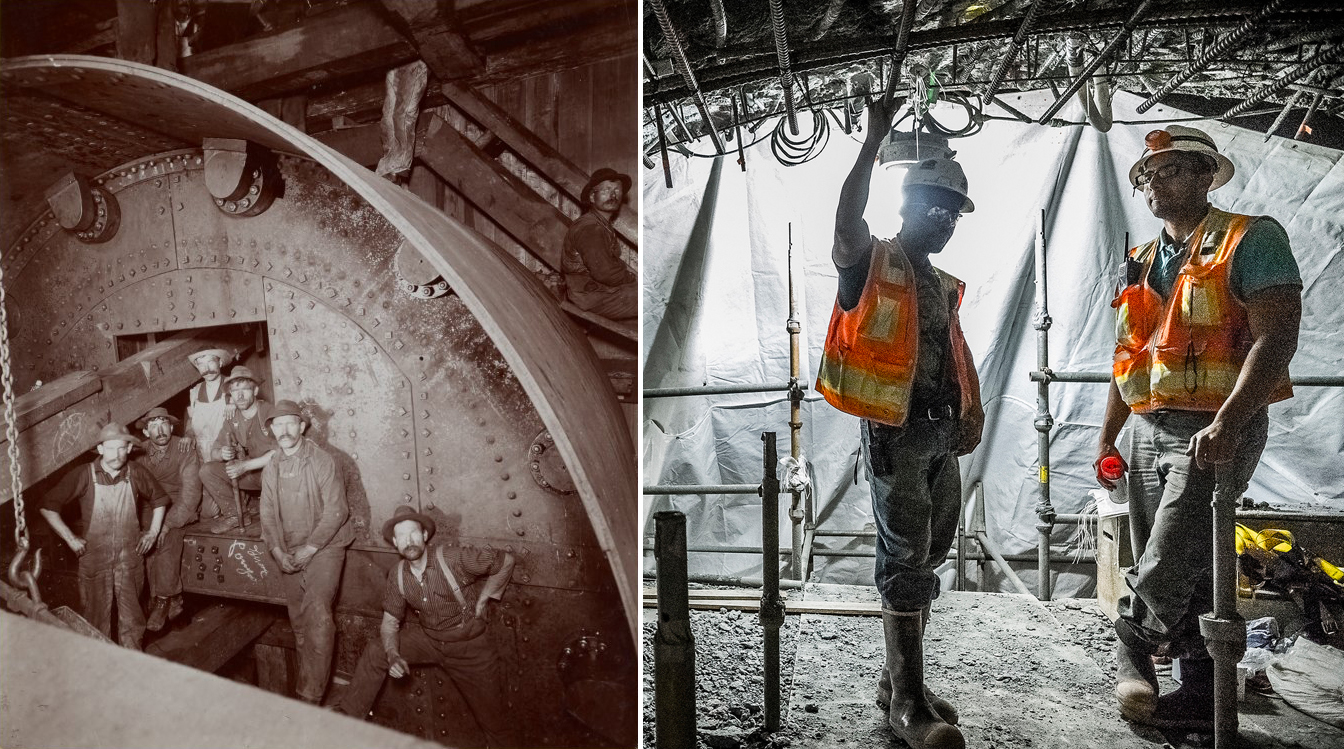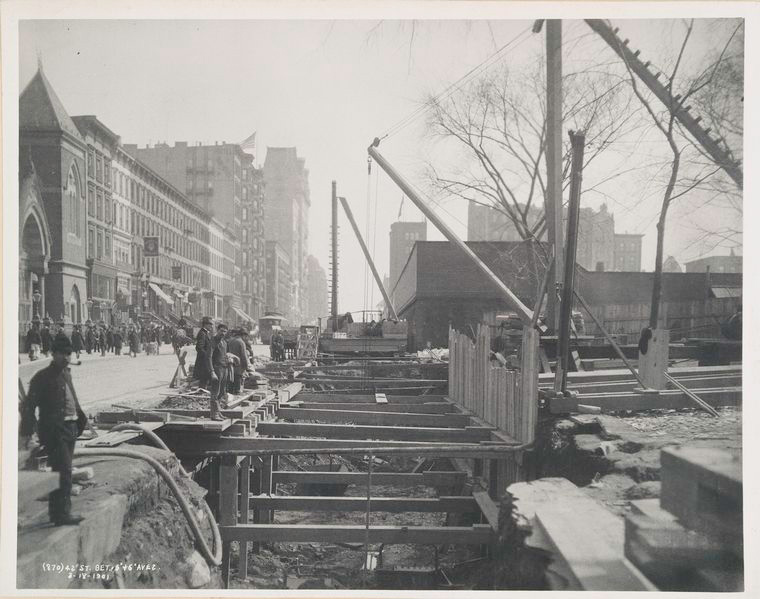Subway Construction: Then and Now
Periodically, the MTA posts images to its Flickr Photostream that document workers’ progress on many projects, including the Second Avenue Subway, the 7 Line Extension, and East Side Access project. Side by side with NYPL’s collection of photographs of the construction of New York’s first subway, which opened in 1904, these images provide stark contrast to each other. They are evidence of an industry drastically changed: the methods of construction used, the condition and expressions of the workers, and the scale of the projects differ in striking ways.

The subway is New York City’s central nervous system. The now familiar subway map began to take shape with the opening of the first Interborough Rapid Transit line in 1904. The shape of the subway system as we know it largely developed within its first thirty years of service.
New York’s first successful* subway was built expeditiously. When the contract went out for bidding, it stipulated that “the work was to be done and the road ready for operation in two years.” (1) The contract was won by a company called the Rapid Transit Construction Company, which evolved into the Interborough Rapid Transit Company (the IRT, as New Yorkers would come to know it) (2). This is a contrast to the current Second Avenue Subway project, which broke ground in 2007 and is still under construction.

Abram Hewitt, mayor 1887-1888, earned the nickname “Father of the Subway” by facilitating the legislation, money, and cooperation of several public and private agencies needed for such a large scale project. Hewitt collaborated with the city’s mercantile elite and created the first detailed, workable proposal for an underground rapid transit system. His designs primarily served the function of providing convenient travel for workers and customers to shopping and manufacturing centers in downtown Manhattan (3). In 1891, New York State passed the Rapid Transit Act, which would provide cities with over 1 million inhabitants means for the creation of rapid transit. Groundbreaking for the subway would take place under a different mayor, Robert Van Wyck, in 1900. At the groundbreaking, “there were many well-informed people, including prominent financiers and experienced engineers, who freely prophesied failure” (4). However, when the subway opened on October 27, 1904, it quickly became the travel system of choice for New Yorkers and effectively sped up New York’s development as a world-class metropolis (3).
William B. Parsons is the chief engineer credited for the construction of the first subway (as well as the Hudson Tubes, the East River Tunnels, and the Panama Canal). Parsons’ obituary in the New York Herald Tribune explains that his work on the subway was “an engineering task that had no precedent,” and explains the difficulties of the construction:

Construction techniques are described in detail in The New York subway: its construction and equipment, a promotional item published by the Interborough Rapid Transit Company to celebrate its 1904 opening. The selection of the subway’s initial route was governed largely by the funds available and approved by voters. The work was primarily done by open excavation, also called the “cut-and-cover” system.
The typical subway route (called “road” in this text) was built near the surface with a flat roof and “I” beams for roof and sides and supported between tracks with columns. Not all of the construction took place in a uniform matter, partly due to the views of the different subcontractors who built different sections of the subway simultaneously.
Contractors faced a variety of challenges in building. Natural obstacles included ground water, rock formations, and the former canal for which Canal Street is named. Man-made difficulties included re-routing over 12 miles of sewers, as well as water and gas mains, steam pipes, and electric conduits. Pneumatic tubes used by the Postal Service could not be disturbed and had to be kept carefully aligned. Also, the street railways which the subway frequently replaced were disassembled to make way for the subway. Construction often ran near the foundations of tall buildings, requiring engineers to ensure the stability of both the buildings and the new subway routes. Another challenge would be encountering certain underground rooms and vaults (such as bank vaults) which sometimes encroached on the new subway’s path. Underpinning the Columbus Monument was particularly difficult.
Drilling was done by a night shift and followed by early morning blasting of rock. A day crew would then remove the debris by mule cart. Several houses were damaged on Park Avenue from blasting irregular rock formations with angled strata. The New York Times reported that despite this hurried and unprecedented construction, relatively few accidents occurred:

The value of human life has changed in modern perceptions. The Times had a different spin on these events when recalling the first subway in a report on the Second Avenue Subway’s progress in August, 2012.

The first underground line was a resounding success. Calls for expansion began immediately. On May 25, 1905 the New York Times ran an article “Subway Extension Plans” which said that the subway “beyond all expectation proved successful, and its operation is so profitable that private capital to the apparent amount of $225,000,000 now appears at the council table of the Rapid Transit Commission competing for the privilege of building many new subway lines extending and completing the present system.” Indeed, the economic impact of good transit remains high according to recent evaluations published in Urban Studies. This is contrasted by the Second Avenue Subway, where phases 2, 3, and 4 of the construction plan are still unfunded. In 1905, The Times advocated that “it would be a good policy also to have competition between the operating companies” and that “new subways may be built by each of the rival bidders.” Indeed, this competition led to rival companies servicing downtown Manhattan extensively and other areas of the city less so.
The Second Avenue Subway has been a proposed but unrealized project since 1929. New York Times Magazine called it “the great failed track New York City has been postponing, restarting, debating, financing, definancing and otherwise meaning to get in the ground since 1929.” The Great Depression was the first calamity to take the project out of development, and after subway unification in the 1940s, “one of the TA’s (Transit Authority’s) decisive actions in getting control of the mess it inherited was to shelve the Second Avenue subway plan indefinitely” (Kramer). The Second Avenue Subway line was revitalized in the 1990s, and the final Environmental Impact Report was approved in 2004.
Tunnel making in the past was primarily accomplished with dynamite. Construction of the Second Avenue Subway and other MTA projects primarily use deep tunnel boring methods and a gargantuan tunnel boring machine. This type of construction eliminates disruptions for road traffic, pedestrians, utilities and local businesses that cut-and-cover created. Some, but not all, of the subway stations are still created with cut-and-cover construction. ENR New York specifies the particulars of the engineering project in this article: “New York's Subway System Finally Starting Major Expansion.” The MTA keeps an online list of their milestones in Second Avenue Subway progress. The first section of this line is estimated to open in December, 2016. The 7 Line Extension, originally planned as two further westerly stops on the 7 train, will open its solo new station at 34th Street and 11th Avenue later this year.
A Subway History Reading List

The New York Subway: Its Construction And Equipment: Interborough Rapid Transit, 1904 / with an introduction by Brian J. Cudahy.
722 Miles: The Building Of The Subways And How They Transformed New York / Clifton Hood.
The Routes Not Taken: A Trip Through New York City's Unbuilt Subway System / Joseph B. Raskin.

The Wheels That Drove New York: A History Of The New York City Transit System / Roger P. Roess and Gene Sansone.
The City Beneath Us: Building The New York Subways / New York Transit Museum with Vivian Heller.
Subways: The Tracks that Built New York City / Lorraine B. Diehl.

A Century Of Subways: Celebrating 100 Years Of New York's Underground Railways / Brian J. Cudahy.
Evolution Of New York City Subways: An Illustrated History Of New York City's Transit Cars, 1867-1997 / by Gene Sansone ; with a new foreword by Clifton Hood.
Read E-Books with SimplyE
 With your library card, it's easier than ever to choose from more than 300,000 e-books on SimplyE, The New York Public Library's free e-reader app. Gain access to digital resources for all ages, including e-books, audiobooks, databases, and more.
With your library card, it's easier than ever to choose from more than 300,000 e-books on SimplyE, The New York Public Library's free e-reader app. Gain access to digital resources for all ages, including e-books, audiobooks, databases, and more.
If you don’t have an NYPL library card, New York State residents can apply for a digital card online or through SimplyE (available on the App Store or Google Play).
Need more help? Read our guide to using SimplyE.


Comments
Subway engineer ,circa 1935 -1945
Submitted by M.m. Tureski (not verified) on August 10, 2017 - 7:12pm